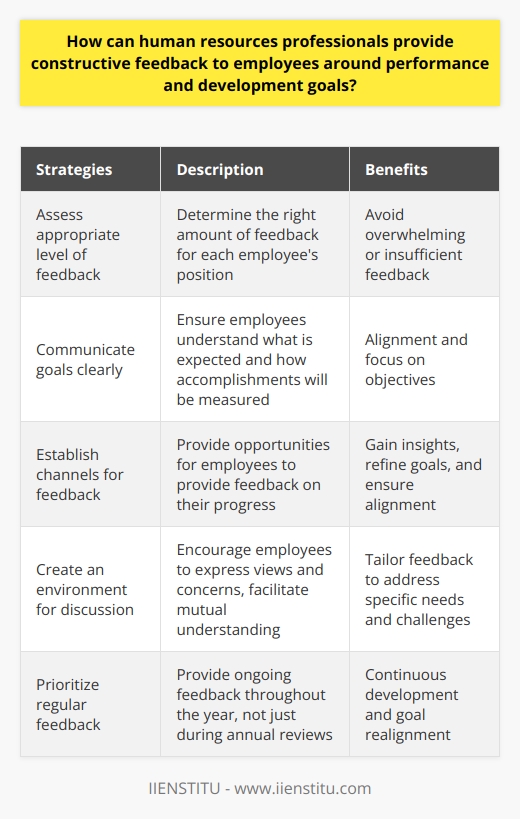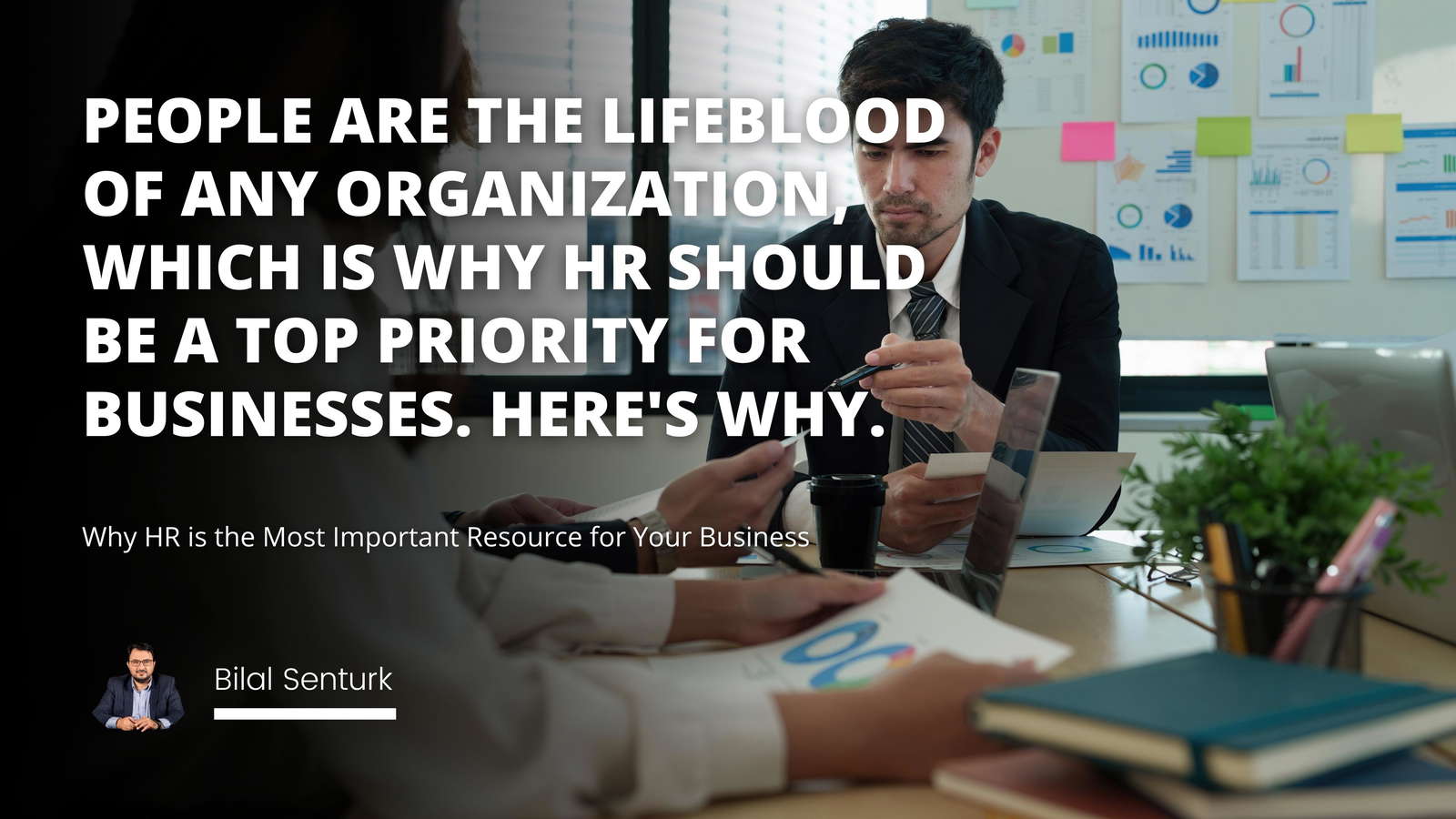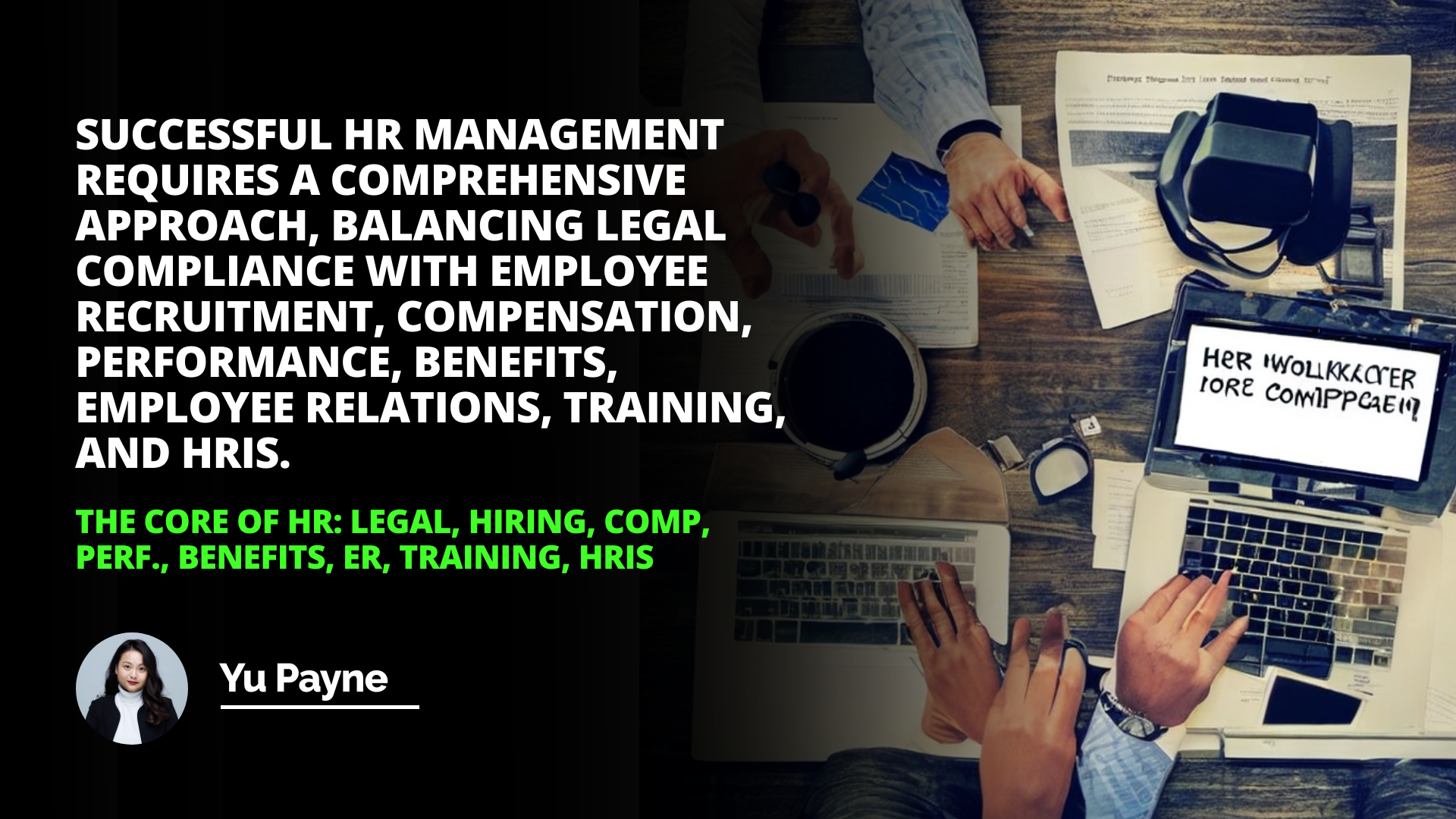
When I first began my journey in the field of Human Resources, I was captivated by the sheer breadth of responsibilities that come with the territory. It wasn't just about payroll or hiring; it was about being the heartbeat of the organization. I remember sitting in my small HR office—affectionately termed the "human rec corner" by my colleagues—and realizing that human and resources are inextricably linked in shaping the company's future.
Legal aspects of HR
Hiring Processes
Compensation and Performance
Employee Benefits, ER, and Training
The Role of HRIS
Navigating the Legal Labyrinth of HR
One of the first challenges I faced was understanding the legal aspects of HR. It's a complex area, but absolutely crucial. Ensuring compliance with labor laws isn't just about avoiding lawsuits—it's about fostering a fair and ethical workplace. I recall a time when we had to update our policies due to new legislation. It was a whirlwind of meetings and document revisions, but in the end, it reinforced the trust between HR human and staff.
Key legal areas in HR include:
Employment law compliance
Equal Employment Opportunity Commission (EEOC) regulations
Anti-discrimination policies
Dispute resolution procedures
Understanding these elements is not just paperwork; it's about protecting both the employer and the employee. For instance, when dealing with a reassignment request letter, knowing the tips and information on legal compliance ensures that we handle the situation fairly and legally.
The Art and Science of Hiring Processes
Hiring isn't just filling a vacancy—it's about finding the right person who fits both the role and the company culture. In my early days, I underestimated the importance of a well-crafted job description. But I've learned that a short HR briefing can make all the difference. It sets clear expectations and attracts candidates who resonate with our values.
Steps in an effective hiring process include:
1- Defining the role and requirements
Businesses Partnering With Education Companies To Reduce Workplace İlliteracy
The Role Of Human Resource Management İn Business Operations
Workplace Harassment: Effects, Legal Issues and Prevention Strategies
Human Resources: From Reactive to Proactive in the Workplace
Human Resources Job Description: Your Comprehensive Guide to HR Roles
2- Drafting a compelling job description
3- Sourcing candidates through various channels
4- Conducting interviews and assessments
5- Performing background checks
6- Extending an offer and onboarding
I remember interviewing a candidate who, on paper, seemed underqualified. Yet, during the interview, their passion and alignment with our company culture were undeniable. That experience taught me that sometimes, beyond the human resources information stored in human resource management information systems, intuition plays a role too.
Balancing Compensation and Performance
Compensation isn't just about salary—it's about recognizing the value an employee brings to the company. Aligning compensation with performance can be a delicate balancing act. Early in my career, we had an exceptional employee whose performance was stellar, but their compensation hadn't kept pace. Addressing this required a deep dive into our compensation structures and performance metrics.
Key considerations for compensation include:
Market salary benchmarks
Performance-based incentives
Recognition programs
Transparent communication
By adjusting our approach, we not only retained top talent but also boosted overall morale. It underscored the importance of human resource HR practices that are both fair and motivating.
Enhancing Employee Benefits, Relations, and Training
Successful HR management requires a comprehensive approach to balancing legal compliance with employee recruitment compensation performance benefits, employee relations training, and HRIS.
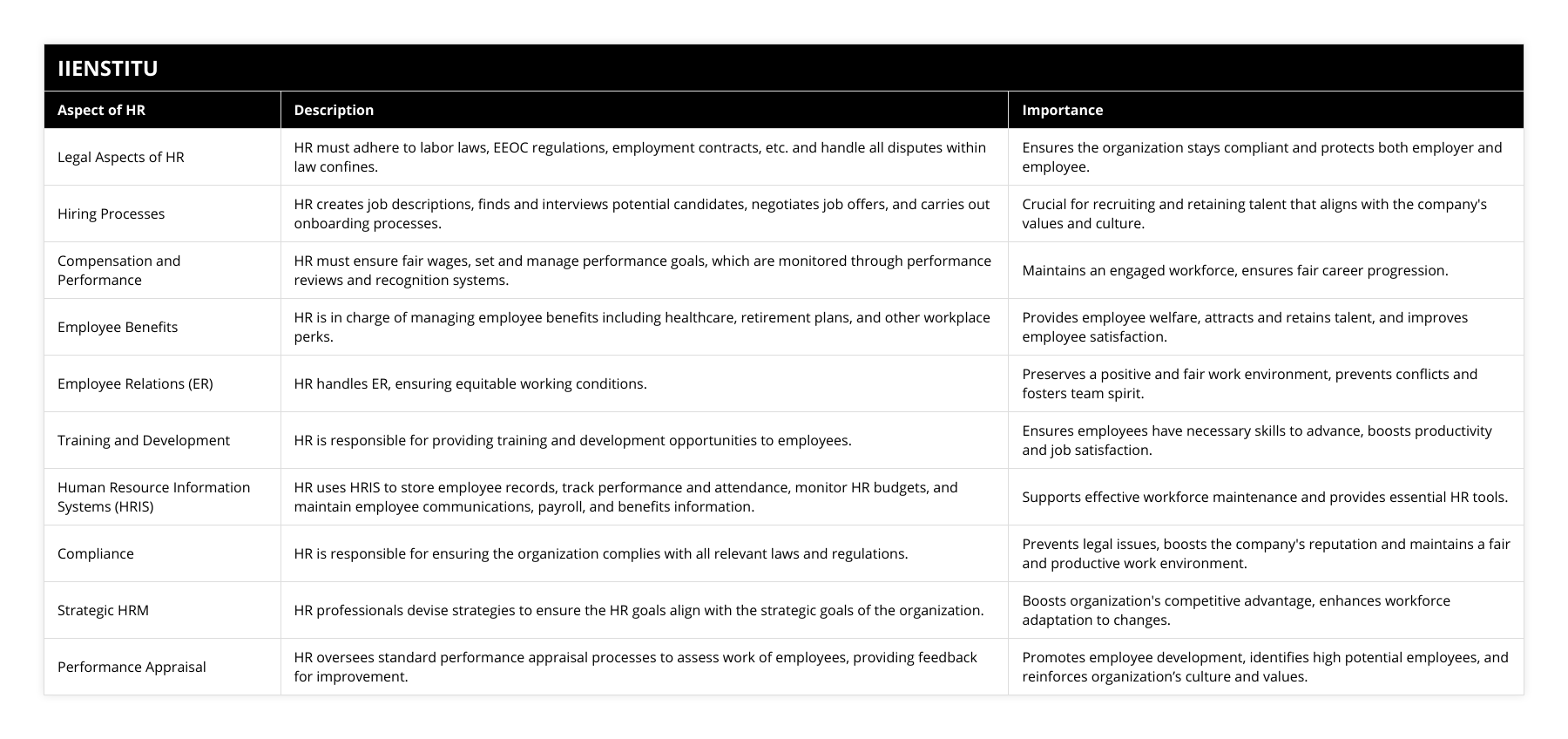
Employee benefits are more than just perks—they're essential components of job satisfaction. Offering comprehensive benefits shows employees that we value their well-being. We once revamped our health benefits package based on employee feedback, which led to higher satisfaction scores.
Important aspects of employee benefits:
Health and wellness programs
Retirement plans
Flexible working arrangements
Professional development opportunities
In terms of employee relations, fostering open communication is key. I recall mediating a conflict between two departments. By facilitating a dialogue, we not only resolved the issue but also improved interdepartmental collaboration.
Effective employee relations strategies include:
Active listening
Conflict resolution mechanisms
Employee feedback systems
Recognition and appreciation
Training and development cannot be overlooked. Investing in employees' growth leads to a more skilled and engaged workforce. Our resources human resources department organized quarterly workshops, which became highly anticipated events.
The Vital Role of HRIS
In today's digital age, leveraging technology is essential. Implementing a robust Human Resource Management Information System (HRMIS) revolutionized how we managed data. From tracking leave balances to performance appraisals, the system became an indispensable tool.
Benefits of an HRIS include:
1- Streamlined data management
2- Improved accuracy and compliance
3- Enhanced reporting capabilities
4- Better employee self-service options
Integrating an HRIS wasn't without its challenges. Training the team was a significant undertaking, but the payoff was immense. It freed up time for us to focus on strategic initiatives rather than administrative tasks.
Conclusion
Looking back, the interconnectedness of all these HR facets is clear. Successfully managing human resources requires a holistic approach that balances legal compliance, effective hiring, fair compensation, robust employee benefits, strong relations, ongoing training, and leveraging technology through resources HR systems.
Each element supports the others. Legal compliance underpins fair hiring practices. Effective compensation strategies enhance performance management. Employee benefits and relations foster a positive workplace culture, and training ensures continuous growth. All of this is facilitated by a solid HRIS.
By embracing all aspects of human resource HR, we create an environment where both the organization and its people can thrive. It's about recognizing that at the heart of every company are its human resources resources—the people who drive success every day.
References
Armstrong, M. (2014). Armstrong's Handbook of Human Resource Management Practice. Kogan Page.
Dessler, G. (2017). Human Resource Management. Pearson.
Mathis, R. L., & Jackson, J. H. (2015). Human Resource Management: Essential Perspectives. Cengage Learning.
Noe, R. A. (2016). Employee Training & Development. McGraw-Hill Education.
Ulrich, D. (1996). Human Resource Champions: The Next Agenda for Adding Value and Delivering Results. Harvard Business School Press.
Note: This text is based on personal experiences and reflects general practices in the field of human resources.
Frequently Asked Questions
What legal issues do human resources professionals need to consider when making decisions?
.When making decisions, Human Resources (HR) professionals must consider legal issues that could affect their employees and business operations. This is especially true in decision-making, such as hiring, firing, disciplining employees, administering benefits, and enforcing company policies.
Employment laws, both federal and state, generally have provisions that cover these areas. Therefore, HR professionals must familiarize themselves with applicable laws, regulations, and business policies, ensuring all decisions are suitable for the company and consistent with applicable laws.
To start, HR practitioners must understand contractual laws. Employers and employees often enter agreements regarding wages, hours, benefits, and other labor-related issues. All contractual matters must comply with all applicable laws, including wage and hour, minimum wage, wage garnishments, and other wage and hour laws. Additionally, HR professionals must understand and comply with regulations governing how long employees should work, how many hours they can work, and how much vacation, the sick, and personal time they can accrue.
In addition, various protections are guaranteed to employees through numerous anti-discrimination and anti-retaliation laws. However, discrimination and retaliation against current, former, and prospective employees can have significant legal implications, so iHR professionals must exercise discretion when making decisions in these areas.
Finally, HR professionals need to understand employee privacy rights. Privacy laws dictate the types of information businesses can access and store. Companies are generally prohibited from accessing the private information of their employees without the employee’s knowledge and consent.
In conclusion, HR professionals must understand the legal issues of making decisions before taking action. Awareness of applicable laws, contractual arrangements, employee rights, and privacy laws is essential. By following this advice, HR professionals can help ensure their decisions comply with the law and benefit the company.
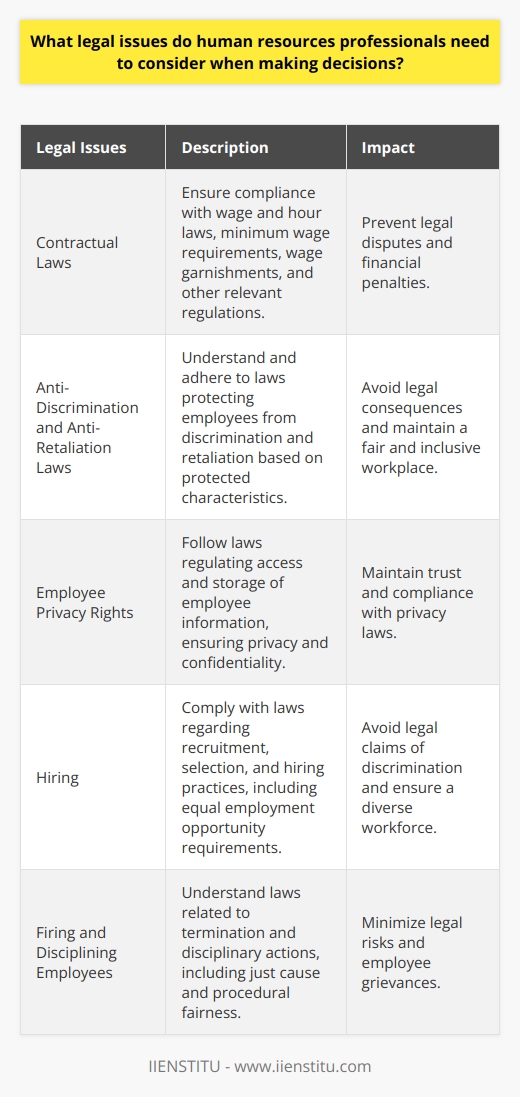
How can human resources professionals ensure that hiring processes are fair and unbiased?
.The need for fair and unbiased hiring processes is becoming increasingly important in today's workplace. Human resources professionals are especially critical in this regard, as they create and manage the methods used to select and hire candidates. To help ensure that hiring processes remain fair and unbiased, human resources professionals must take several steps.
First, human resources professionals should take special care to ensure that all job postings and advertisements are written in a non-discriminatory and gender-neutral manner. By avoiding language or images that may favor certain groups, or that may be interpreted as an attempt to exclude potential candidates, human resources professionals can ensure that job postings do not create barriers to entry.
Second, human resources professionals should develop job descriptions that accurately reflect a role's duties without emphasizing specific qualifications or experiences. Unless necessary, job descriptions should not include requirements such as education levels, certifications, or years of experience, as they may be used to exclude specific segments of the population. By keeping job descriptions open-ended and focused on the core competencies of the role, human resources professionals can ensure that the right person gets the job, regardless of what is stated on paper.
Third, human resources professionals must carefully design and monitor the screening process to decide which job applicants to interview. Screening processes must be impartial and should focus on the skills and abilities of the candidate rather than any demographic factors or other non-work-related elements. By making sure that selection decisions are based on objective criteria, human resources professionals can ensure that their hiring processes remain fair and unbiased.
Finally, human resources professionals should consider implementing strategies, such as blind recruitment, to prevent biased decision-making later in the selection process. Such plans can include removing identifying information from resumes and providing objective tests to assess candidates' qualifications. By establishing systems to promote equal treatment of all applicants, recruitment processes can be as impartial as possible.
Overall, human resources professionals have a crucial role to play in helping to ensure that hiring processes are fair and unbiased. By being mindful of the potential for bias at every stage of the recruitment process, human resources professionals can ensure that the best candidate is selected for the job, regardless of any demographic factors.
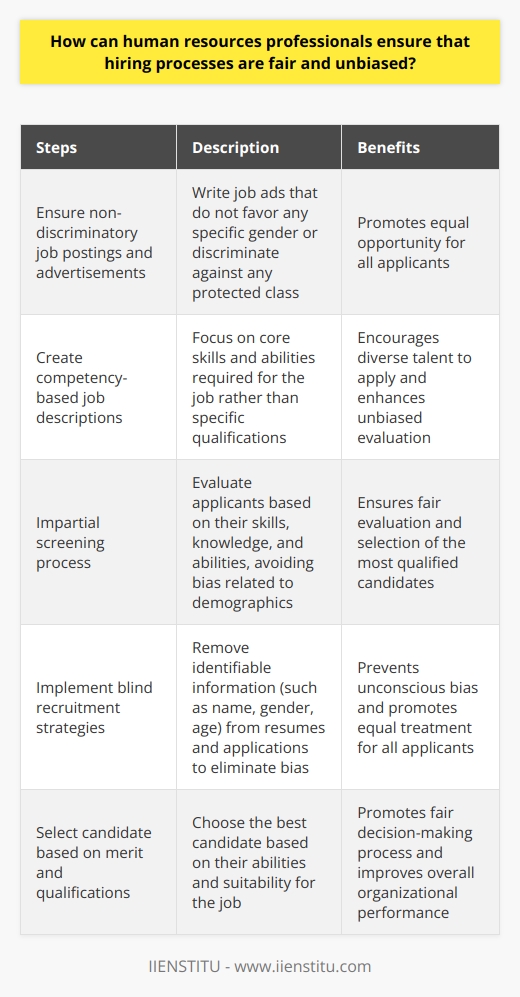
How can human resources professionals provide constructive feedback to employees around performance and development goals?
Human Resources professionals' role is integral to any organization's success. Therefore, they must ensure that employees have the necessary feedback to reach peak performance and development goals. Constructive feedback benefits employees by providing a platform to develop their skills understand their responsibility, and impact plans and objectives. Here are five strategies Human Resources professionals can use to provide constructive feedback to employees regarding performance and development goals.
First, Human Resources professionals must ensure that the level of feedback is appropriate for the employee's position and organizational policy. Too much feedback can lead to confusion and distress, but too little feedback can mean employees are not adequately informed of their performance or goals. Therefore, it is essential to strike the perfect balance.
Second, Human Resources professionals should communicate the goals clearly and concisely. Employees should be aware of their expectations and how their performance or development goals will be measured.
Third, Human Resources professionals should create avenues to solicit feedback from employees. This should include questions about how employees perceive their progress toward the goal and how the performance feedback is implemented.
Fourth, when feedback is given, it should be provided in a way that allows for discussion and refinement. Finally, performance feedback should remain positive while focusing on what can be done to ensure growth and development.
Finally, Human Resources professionals should ensure that feedback is given regularly. This helps ensure that both performance and development goals are achieved and monitored.
In summary, Human Resources Professionals should implement these strategies to effectively provide employees with constructive feedback around performance and development goals. These strategies help ensure that employees are achieving both short-term and long-term objectives while also helping to ensure that the organization succeeds.
